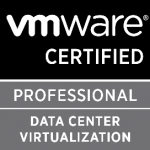For a list of all objectives see the VCP5 page.
Objective 6.4 – Perform Basic Troubleshooting for HA/DRS Clusters and vMotion/Storage vMotion
For HA and DRS see also: HA Deepdive and DRS Deepdive.
Identify HA/DRS and vMotion requirements (similar as vSphere 4.x)
See the vSphere Availability guide (page 11) and the vSphere Resource Management guide (page 51). Basically a shared storage is required, some network configurations, and (for DRS and vMotion) a CPU compatibility or the EVC function in the cluster.
Verify vMotion/Storage vMotion configuration (similar as vSphere 4.x)
See the vCenter Server and Host Management guide (page 119 and 122). For the network for vMotion a vmkernel interface is required (note that now vSphere 5 can use more interfaces). For Storage vMotion the main requirement is that the host can see both storages.
Verify HA network configuration (new in vSphere 5)
See the vSphere Availability guide (page 13). Heartbeat can go through the vmkernel management interfaces (or other specific interfaces)… but now with vSphere also thought the shared storage.
Verify HA/DRS cluster configuration (similar as vSphere 4.x)
See the vSphere Availability guide (page 11) and the vSphere Resource Management guide (page 51). Some new windows are now available to check HA and DRS status.
Troubleshoot HA capacity issues (similar as vSphere 4.x)
See the vSphere Troubleshooting guide (page 31). When planning for HA you need to plan for a maximum host failure; the number of hosts that can fail before you run short on resources. When VMs can no longer start this might be due to a lack of resources (memory is quite common) with warnings like “insufficient resources to satisfy failover level”.
Troubleshoot HA redundancy issues (same as vSphere 4.x)
See the vSphere Availability guide (page 11).
Interpret the DRS Resource Distribution Graph and Target/Current Host Load Deviation (same as vSphere 4.x)
See VMware DRS Resource Distribution Chart.
Troubleshoot DRS load imbalance issues (similar as vSphere 4.x)
See the vSphere Resource Management guide (page 62).
Troubleshoot vMotion/Storage vMotion migration issues (similar as vSphere 4.x)
See the vCenter Server and Host Management guide (page 119 and 122). Check also compatibility with snaphosts.
Interpret vMotion Resource Maps (similar as vSphere 4.x)
Topology maps are a easy way to show you the network and storage connection from an to hosts and/or VMs. As stated above there are some requirements to the use of vMotion live storage, networking etc. A first and easy check is to look at the topology maps and see if these requirements are met. Maps can be found when selecting a server and than selecting the tab Maps.
Identify the root cause of a DRS/HA cluster or migration issue based on troubleshooting information (similar as vSphere 4.x)
See all the previous references and also Perform Basic Troubleshooting for HA/DRS. For HA failover see also the vSphere Troubleshooting guide (page 34).











